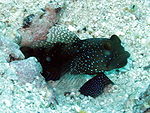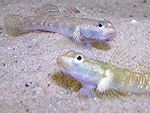- Goby
-
For other uses, see Goby (disambiguation).
Gobies 
Microgobius gulosus Scientific classification Kingdom: Animalia Phylum: Chordata Class: Actinopterygii Order: Perciformes Suborder: Gobioidei Family: Gobiidae
Regan, 1911Subfamilies Amblyopinae
Benthophilinae
Gobiinae
Gobionellinae
Oxudercinae
Sicydiinae
See also list of Gobiidae generaThe gobies form the family Gobiidae, which is one of the largest families of fish, with more than 2,000 species in more than 200 genera.[1] Most are relatively small, typically less than 10 cm (4 in) in length. Gobies include some of the smallest vertebrates in the world, like species of the genera Trimmatom nanus and Pandaka pygmaea, which are under 1 cm (3/8 in) long when fully grown. There are some large gobies, such as some species of the genera Gobioides or Periophthalmodon, that can reach over 30 cm (1 ft) in length, but that is exceptional. Although few are important as food for humans, they are of great significance as prey species for commercially important fish like cod, haddock, sea bass, and flatfish. Several gobies are also of interest as aquarium fish, such as the bumblebee gobies of the genus Brachygobius.
The most distinctive aspects of goby morphology are the fused pelvic fins that form a disc-shaped sucker. This sucker is functionally analogous to the dorsal fin sucker possessed by the remoras or the pelvic fin sucker of the lumpsuckers, but is anatomically distinct: these similarities are the product of convergent evolution. Gobies can often be seen using the sucker to adhere to rocks and corals, and in aquariums they will happily stick to glass walls of the tank, as well.
 Whip coral dwarf goby, (Bryaninops youngei) on a whip coral from East Timor
Whip coral dwarf goby, (Bryaninops youngei) on a whip coral from East Timor
Gobies are primarily fish of shallow marine habitats including tide pools, coral reefs, and seagrass meadows; they are also very numerous in brackish water and estuarine habitats, including the lower reaches of rivers, mangrove swamps, and salt marshes. A small number of gobies (unknown exactly, but in the low hundreds) are also fully adapted to freshwater environments. These include the Asian river gobies (Rhinogobius spp.), the Australian desert goby (Chlamydogobius eremius), and the European freshwater goby Padogobius bonelli. Most gobies feed on small invertebrates, although some of the larger species eat other fish, and a few eat planktic algae.
Contents
Mudskippers
Main article: MudskipperMudskippers are highly specialized members of the family, usually ascribed to the subfamily Oxudercinae. They are able to survive for extended periods on land through a combination of behavioral and physiological adaptations, including pectoral fins that act as simple legs; the ability to breathe through their skins (like frogs); and the digging of damp burrows to avoid drying out. Mudskippers live in tidal areas, particularly on mudflats and in mangrove forests, and are only found in tropical and subtropical regions.
Reproduction
Gobies attach their eggs to a substrate, such as vegetation, coral, or a rock surface. They can lay anywhere from five to a few hundred eggs, depending on species. After fertilizing the eggs, the male remains to guard them from predators and keep them free from detritus. The eggs hatch after a few days. The larvae are born transparent, developing their coloration after dispersing to find a suitable habitat. The larvae of many freshwater species are carried downstream to the brackish waters of estuaries, or even to the sea, and only return to fresh water weeks or months later.[2]
Gobies in warmer waters reach adulthood in a matter of months, while those in cooler environments may take up to two years. The total lifespan of gobies varies from a single year to up to ten years, again with the temperate species generally living longer.[2]
A few species of goby are known to be able to change sex from female to male, although most do not do this. In such species, most individuals are born female, and the male must expend considerable effort in guarding the eggs of the multiple females with which he breeds.[2]
Symbiosis
Gobies sometimes form symbiotic relationships with other species.[3] Some goby species live in symbiosis with burrowing shrimps. The shrimp maintains a burrow in the sand in which both the shrimp and the goby live. The shrimp has poor eyesight compared to the goby, but if it sees or feels the goby suddenly swim into the burrow, it will follow. The goby and shrimp keep in contact with each other, the shrimp using its antennae, and the goby flicking the shrimp with its tail when alarmed. These gobies are thus sometimes known as watchmen or prawn gobies. Each party gains from this relationship: the shrimp gets a warning of approaching danger, and the goby gets a safe home and a place to lay its eggs. Only the alpha male and female reproduce, other fish in colony eat sparingly to resist being eaten by the alpha male or female. This way only the largest and fittest are able to reproduce.[citation needed]
Another example of symbiosis is demonstrated by the neon gobies (Elacatinus spp.). These gobies are known as "cleaner gobies", and remove parasites from the skin, fins, mouth, and gills of a wide variety of large fish. The most remarkable aspect of this symbiosis is that many of the fish that visit the gobies' cleaning stations would otherwise treat such small fish as food (for example, groupers and snapper[disambiguation needed
 ]s). Again, this is a relationship where both parties gain: the gobies get a continual supply of food as bigger fish visit their cleaning stations, and the bigger fish leave the cleaning stations healthier than they were when they arrived.
]s). Again, this is a relationship where both parties gain: the gobies get a continual supply of food as bigger fish visit their cleaning stations, and the bigger fish leave the cleaning stations healthier than they were when they arrived.In aquariums
Several species of gobies are kept in aquariums. [4] Most captive gobies are species from saltwater, and make excellent additions to healthy reef or fish-only aquariums. Perhaps the most popular is the small but colorful neon goby. Most gobies stay toward the lower portion of the aquarium, hiding in the rockwork, but some species (most notably the shrimp gobies) prefer to dig themselves little burrows. Potential keepers of these striking fish should provide them with a fine grained substrate to prevent damage to their delicate undersides. Commonly kept saltwater species include the engineer goby, Randall's shrimp goby, and watchman goby. The bumblebee gobies from the genus Brachygobius are perhaps the most widely traded freshwater species, being small, colorful, and easy to care for. They need tropical, hard and alkaline freshwater or slightly brackish conditions to do well. Gobies are generally peaceful towards their tankmates, though territorial among themselves. Since most are small and few are predatory toward other fishes, they usually make good community fishes. Typically, the main problem with gobies is feeding them: with a few exceptions, the small species kept in aquariums prefer live on frozen foods rather than flake, and they are not very good at competing with active species such as cichlids. Another problem is that it is very common for them to jump out of the tank so having a tight fitting lid is a must. It is often recommended that gobies be kept on their own or with peaceful surface dwelling species such as halfbeaks and guppies.
See also
- Sleeper gobies are a closely related family (Eleotridae) that lack the fused pelvic fin sucker typical of most gobies, but are otherwise very similar in size, shape, and ecology.
- Blennies are a group of shallow water marine fish often confused with gobies.
- Dragonets are superficially similar to gobies and sometimes confused with them.
References
- ^ Froese, Rainer, and Daniel Pauly, eds. (2006). "Gobiidae" in FishBase. January 2006 version.
- ^ a b c Hoese, Douglas F. (1998). Paxton, J.R. & Eschmeyer, W.N.. ed. Encyclopedia of Fishes. San Diego: Academic Press. pp. 218–222. ISBN 0-12-547665-5.
- ^ G. S. Helfman, B. B. Colette & D. E. Facey (1997). "Chapter 21: Fishes as social animals". The Diversity of Fishes. Blackwell. ISBN 0-86542-256-7.
- ^ Frank Schäfer (2005). Brackish-Water Fishes. Aqualog. ISBN 3-936027-82-X (English), ISBN 3-936027-81-1 (German).
External links
- Gobioid Research Institute
- Themudskipper.org: a website on mudskippers
- Mudskipper and goby page for aquarists
- Article on cleaner gobies in aquaria
- Brackish water aquarium FAQ entry on gobies
Wikimedia Foundation. 2010.




